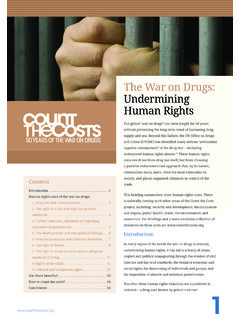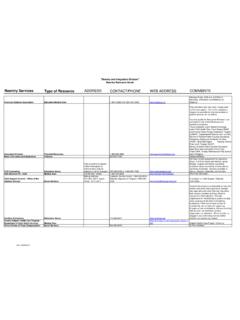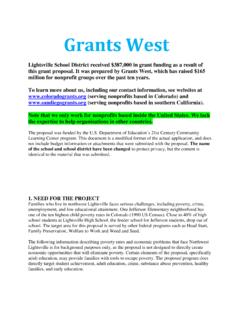Transcription of The War on Drugs: Promoting stigma and …
1 1 Criminalisation of people who use drugs 3 Media potrayals 3 Limited employment prospects and life chances 5 Reduced standards of welfare 5 Voter disenfranchisement 5 Restricted access to healthcare 5 Torture and abuse 6 Criminalisation of drug production and trafficking 7 The stigma and discrimination costs of the war on drugs.
2 1 Ethnic minorities 72 Women 83 Children and young people 94 Indigenous peoples 105 People living in poverty 11 Are there benefits? 12 How to count the costs? 12 Conclusions 13 The War on Drugs.
3 Promoting stigma and discriminationThe global war on drugs has been fought for 50 years, without preventing the long-term trend of increasing drug supply and use Beyond this failure, the UN Office on Drugs and Crime (UNODC) has identified many serious negative unintended consequences (1) of the drug war including the stigma and discrimination faced by a range of populations These costs are distinct from those relating to drug use, stemming as they do from the choice of a punitive enforcement-led approach that, by its nature, criminalises many users often the most vulnerable in society This briefing summarises these stigma and discrimination costs There is naturally overlap with other areas of the Count the Costs project, including.
4 Security and development, human rights, crime, the environment, and economics For briefings and a more extensive collection of resources on these costs, see www countthecosts org Introduction Despite the lack of evidence that more punitive drug laws significantly deter drug use, criminalisation remains the primary weapon in the war on drugs But using the criminal justice system to solve a public health problem has proven not only ineffective, but also socially corrosive It promotes stigmatisation and discrimination, the burden of which is largely carried by already marginalised or vulnerable populations, many of whom the policy is nominally designed to protect Discrimination is the prejudicial treatment of a person based on the group, class or category to which that person belongs It is inevitably linked to stigma , the social and practical manifestation of a distinguishing mark of social disgrace (2)
5 Although all drug use particularly when linked with public intoxication has been associated with social disapproval, there is a striking variation in how this is expressed for different drugs and using environments While it certainly surrounds users of all illicit drugs, stigma , as defined above, can be amplified by politically manufactured moral panics around certain drugs, groups or populations stigma is also markedly less evident for users of licit drugs such as alcohol or tobacco Social and legal controls certainly exist in relation to these drugs, yet they mostly relate to certain behaviours (such as smoking in public places, or public drunkenness)
6 And are by and large desirable, helping to establish healthy societal norms that minimise potential harms However, these sanctions are of a different order to social disgrace , the severe form of public disapproval reserved for those involved with illicit drugs This disparity is not explained by differences in the effects or potential harms of drugs indeed drug harm rankings consistently rate alcohol and tobacco as equal to or more risky than many illicit drugs (3) Instead, it is the product of policies that, for historically discriminatory reasons, have created parallel and dramatically divergent control regimes for comparable substances Some explanation can be traced to the xenophobic social climate in the US during the 19th and early 20th centuries The emergence of laws criminalising certain drugs was significantly associated with immigrant populations perceived to be the most prolific consumers Chinese users of opium,(4) African Americans users of cocaine,(5)
7 And Hispanic users of marijuana The cultural and legal association of these drugs with otherness and deviance, as distinct from alcohol and tobacco, continues to this day The 1961 UN Single Convention on Narcotic Drugs the founding legal instrument of the war on drugs refers to drug addiction as a serious evil for the individual , and a threat which the international community has a duty to combat because it is fraught with social and economic danger to mankind (6) The use of such language appears to be specifically intended as stigmatising, creating the mark of social disgrace by presenting addicts as a threat to society In this context, the narrative of unintended consequences argued by the UNODC begins to unravel The absence of alcohol and tobacco from such international controls again highlights the arbitrary moral distinctions they propagate Indeed.
8 While tobacco is associated with a level of addiction and health harms that eclipse all other drugs legal and illegal combined, it is nonetheless subject to its own UN convention The Framework Convention on Tobacco Control has a comparable number of state signatories to the three prohibitionist drug conventions, but contains none of the stigmatising language, and by contrast to the 1961 Single Convention, outlines a series of legal, market control measures not punitive prohibitions for the non-medical use of a high-risk drug The arbitrary moral distinction between good and bad psychoactive substances, and the prohibitions established as a result of this distinction, are in themselves a form of discrimination Through criminalisation, the war on drugs compounds the stigma and discrimination experienced by people who use drugs3 Criminalisation of people who use drugsAs with other criminalised behaviours.
9 Drug use (or the criminalisation of possession, which in practice amounts to the same thing) and in particular drug dependence, is taken by many to be an indicator of certain objectionable character traits or dissolute lifestyle choices Indeed, across a number of countries, drug addiction is the most strongly stigmatised of a range of health and social conditions, including homelessness, leprosy, being dirty or unkempt, and possessing a criminal record for burglary (7) This stigma has a range of knock-on effects, all of which further marginalise and threaten the wellbeing of people who use drugs The relationship between criminalisation, stigma and discrimination is undoubtedly complex While criminalisation is an inherently stigmatising process that often leads to discrimination.
10 It is discrimination at wider social and political levels that initiates this process Many affected populations will experience multiple types of discrimination a young black male living in a socially deprived US urban environment, for example The criminalisation implicit in the war on drugs will tend to exacerbate existing inequalities especially where other forms of discrimination exist People who use drugs can be stigmatised or discriminat






